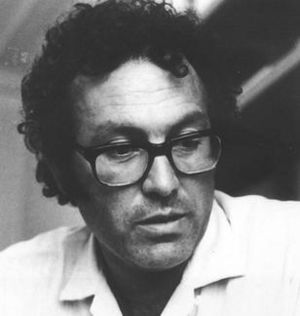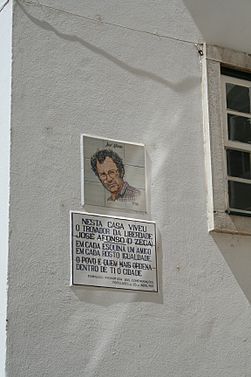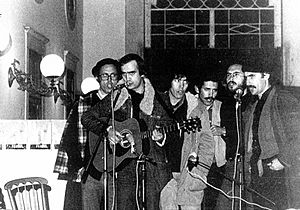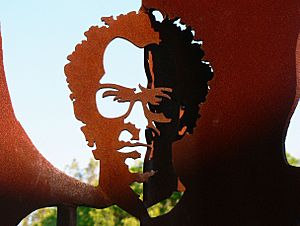José Afonso facts for kids
Quick facts for kids
José Afonso
|
|
|---|---|

José Afonso
|
|
| Background information | |
| Birth name | José Manuel Cerqueira Afonso dos Santos |
| Also known as | Zeca Afonso |
| Born | 2 August 1929 Aveiro, Portugal |
| Died | 23 February 1987 (aged 57) Setúbal, Portugal |
| Genres |
|
| Occupation(s) | Singer, songwriter, teacher, activist |
| Instruments | Vocals, guitar |
| Years active | 1953-1987 |
José Manuel Cerqueira Afonso dos Santos (born August 2, 1929 – died February 23, 1987), known as José Afonso or Zeca Afonso, was a famous Portuguese singer and songwriter. He was one of the most important folk and protest musicians in Portugal's history. He became a symbol in Portugal because his music helped people resist the strict government of the Estado Novo (New State).
Afonso's song "Grândola, Vila Morena" was used as a secret radio signal by the Portuguese Armed Forces on April 25, 1974. This signal started a military action that led to the Carnation Revolution. This revolution brought democracy to Portugal. After this, Afonso and his song "Grândola, Vila Morena" became symbols of the revolution and of fighting against unfair rule. They also represented the workers' movement and left-wing politics in Portugal.
José Afonso's Life Story
Early Years (1929–1940)
José Afonso was born in Aveiro, Portugal, on August 2, 1929. His father, José Nepomuceno Afonso dos Santos, was a judge. His mother, Maria das Dores Dantas Cerqueira, was a primary school teacher.
In 1930, his parents moved to Angola, which was a Portuguese colony in Africa. His father worked there as a judge. José Afonso stayed in Aveiro with his aunt and uncle. His uncle was known for being against the church and for supporting a republic. In 1933, José Afonso went to Angola to live with his parents. He stayed there for three years and started primary school.
He returned to Aveiro in 1936. In 1937, he moved again, this time to Mozambique, another Portuguese colony. His parents and younger siblings were living there.
In 1938, he came back to Portugal to live with his uncle Filomeno, who was the mayor of Belmonte. He finished fourth grade there. His uncle was a strong supporter of the government. He made José Afonso join the "Mocidade Portuguesa". This was a youth group that taught young people the ideas of the Estado Novo government.
Student Life in Coimbra (1940–1956)
José Afonso moved to Coimbra in 1940 to continue his studies. He went to D. João III Lyceum (a type of high school). His family moved from Mozambique to East Timor, another Portuguese territory. His father continued his job as a judge there. José Afonso did not hear from his parents for three years after Japan occupied Timor during World War II. He finally heard from them in 1945.
During his high school years, Afonso started singing serenades. He became known as the "singing creature" because of his unique voice.
From 1946 to 1948, he worked hard to finish high school after failing two years. He secretly married Maria Amália de Oliveira because his parents did not approve. He sang with important university music groups, like the Orfeon Académico de Coimbra. He also played football for Associação Académica de Coimbra.
In 1949, he began studying History and Philosophy at Coimbra University. He traveled to Angola and Mozambique with the Orfeon Académico de Coimbra.
His first son, José Manuel, was born in January 1953. Later that year, he released his first music recordings. These were two 78-rpm records of Coimbra Fado songs.
Between 1953 and 1955, he completed his mandatory military service. He was supposed to go to Macau, a Portuguese territory, but health problems prevented it. He finished his service in Coimbra. His daughter Helena was born in 1954. During this time, he faced many money problems and later divorced his wife.
Teacher and Musician (1956–1968)
In 1956, Afonso released his first EP (Extended Play record) called Fados de Coimbra. After his military service, he started working as a teacher. He taught in Mangualde from January to September 1957. Then he taught in Lagos from October 1957 to July 1959. Because of his money problems, he sent his children to Mozambique in 1958 to live with his parents. That year, he was very interested in Humberto Delgado's campaign for president. Delgado lost because the government cheated in the election.
From October 1959 to July 1960, he taught in Alcobaça. Around 1959 and 1960, he started singing in his unique style. His songs began to include political and social messages. He toured with many groups and became popular with working-class people. In 1960, he released another EP, Balada do Outono.
From 1961 to 1962, he supported student protests that demanded an end to the strict government. The police brutally stopped these protests. He continued to release many songs and added new guitar arrangements. He played in Switzerland, Germany, and Sweden with a fado guitar group.
He released a new EP, Baladas de Coimbra, in 1962. In 1963, he finished his university studies with a paper about Jean-Paul Sartre. He also finalized his divorce that year.
In 1964, he released his first studio album, Baladas e Canções ("Ballads and Songs"). In May 1964, Afonso performed in Grândola. There, he found the idea to write his most famous song, "Grândola, Vila Morena". This song would be recorded years later and would become a signal for the Carnation Revolution in 1974.
From 1964 to 1967, Afonso lived in Maputo and Beira, in Mozambique, with his second wife, Zélia. He was reunited with his children there. In his last two years in Mozambique, he taught in Beira and wrote music for a play by Bertolt Brecht. His daughter Joana was born in 1965. By 1967, after seeing the effects of colonialism and the Portuguese Colonial War, he returned to Lisbon. He left his oldest son, José Manuel, with his grandparents in Mozambique.
Back in Portugal, Afonso started teaching high school in Setúbal. He became very ill and was in the hospital for 20 days. After leaving the hospital, he found out he had been fired from teaching. The government did not like his political ideas and thought his songs were too rebellious. Later, a book of his songs, Cantares de José Afonso, was published. The Portuguese Communist Party asked him to join, but Afonso refused. He signed a contract with the record company Orfeu, which would record most of his music.
Active Against the Government (1968–1974)
In 1968, after being fired from his teaching job, Afonso became a private tutor. He started singing more often with popular groups from the south bank of the Tagus river. This area had many supporters of the Portuguese Communist Party. Around Christmas, Afonso released the album Cantares do Andarilho ("Songs of the Wanderer"). This was his first album with the Orfeu label. Orfeu paid Afonso 15,000 escudos per month, which was a lot of money then. He had to record one album per year.
In 1969, Marcelo Caetano replaced António de Oliveira Salazar as the head of the government. This brought a small bit of democracy to the country. For example, people were allowed to rebuild democratic labor unions. José Afonso joined this movement and supported it. He also took part in student protests against the government in Coimbra. That year, his album Contos Velhos Rumos Novos ("Old Tales New Courses") was released. This was the first time an instrument other than the guitar was used on his album. He won the "best album of the year" award for this album. He won it again in 1970 and 1971. His fourth and last son, Pedro, was also born in 1969.
In 1970, Afonso released the album Traz Outro Amigo Também ("Bring Another Friend as Well"). It was recorded in London. This was his first album without his frequent helper Rui Pato, who was not allowed to travel by Portugal's secret police (PIDE). On March 21, the Portuguese press gave Afonso an award for his "high quality work as a singer and composer" and for his "strong influence on Portuguese popular music." He also performed at an international festival in Cuba.
At the end of 1971, the album Cantigas do Maio ("Songs of May") was released. It was recorded near Paris. Many people think this is his best album. In 1972, he released Eu Vou Ser Como a Toupeira ("I Will Be Just Like The Mole"), recorded in Madrid.
In 1973, José Afonso continued to sing all over Portugal. Many of his shows were stopped by the secret police. In April, he was arrested and spent 20 days in Caxias prison, which was used for political prisoners. In prison, he wrote a poem. For Christmas, he released the album Venham Mais Cinco ("Let Five More Come"), recorded in Paris.
On March 29, 1974, Afonso performed at a concert in Lisbon. It was called the "First Meeting of the Portuguese Song." The government censors were still present. Afonso was not allowed to sing some of his more political songs. However, "Grândola, Vila Morena" was allowed. Less than a month later, on April 25, 1974, the Portuguese government was overthrown in a peaceful military action called the Carnation Revolution. "Grândola, Vila Morena" was one of the two songs used as a secret radio signal by the military. Since then, it has been known as the anthem of the revolution.
Revolutionary Times (1974–1980)
In December 1974, Afonso released the album Coro dos Tribunais ("Courthouse Chorus"). It was recorded in London. The album included two songs he wrote in Mozambique between 1964 and 1967.
From 1974 to 1975, he became deeply involved in the popular revolutionary movements. He performed on March 11, 1975, at a leftist military base. Afonso also worked with a far-left group called LUAR. LUAR released his song "Viva o Poder Popular" (Hail to the People's Power). In Italy, some revolutionary groups released his album República. The money from this album helped striking workers.
In 1976, he supported Otelo Saraiva de Carvalho for president. Otelo was an important leader in the Carnation Revolution. Afonso supported him again in 1980. He released the album Com as Minhas Tamanquinhas ("With My Little Clogs").
The album Enquanto Há Força ("While There is Strength"), released in 1978, showed Afonso's worries about colonialism. It also criticized the Catholic Church. Other Portuguese artists like Adriano Correia de Oliveira and Sérgio Godinho helped with this album.
In 1979, the album Fura Fura ("Drill Drill") was released. It included songs written for theater plays. He also performed at an Anti-Eurovision Festival in Brussels.
Zeca's Final Years (1980–1987)
In 1981, after two years away from the public eye, Afonso returned to his roots in Coimbra with the album Fados de Coimbra e Outras Canções ("Coimbra fados and other songs"). He performed in Paris.
In 1982, he started showing the first signs of amyotrophic lateral sclerosis. This is a serious illness that affects the muscles. He performed at the Printemps Festival in Bruges.
On January 23, 1983, Afonso, who was already weakened by his illness, performed a sold-out show in Lisbon. This show was recorded and released as the live album Ao Vivo no Coliseu. Afonso's last concert was on May 25, 1983, in Porto. At the end of 1983, he released the album Como Se Fora Seu Filho ("As If He Was His Son"). The city of Coimbra gave him its Golden Medal. The mayor told him, "Thank you Zeca, come back whenever you wish, this is your home." Afonso replied, "I don't want to become an institution, but I feel very grateful for the honor." The President of Portugal wanted to give him a special award, but Afonso refused to accept it. Also in 1983, Afonso was given his teaching job back. He was sent to a school in Azeitão to teach History and Portuguese. His illness got worse.
In 1985, his last album, Galinhas do Mato ("Guineafowls"), was released. Afonso was too ill to sing all the songs himself. Other singers helped him.
In 1986, he supported Maria de Lourdes Pintasilgo for president. She was a progressive Catholic woman, but she was not elected.
José Afonso died in Setúbal at 3 a.m. on February 23, 1987. He was 57 years old. He died from the illness he had been diagnosed with in 1982. His funeral in Setúbal was held the next day. More than 30,000 people attended. The procession took two hours to travel a short distance. His coffin was covered with a plain red flag, as he had wished. Many fellow musicians carried his coffin. Afonso is buried in the Nossa Senhora da Piedade cemetery in Setúbal.
José Afonso's Legacy
On November 18, 1987, the José Afonso Association was created. Its goal is to continue Afonso's work in Portuguese music and art.
In 1991, the city of Amadora put up a 3.7-meter (12-foot) statue of José Afonso in its Central Park.
On June 30, 1994, a festival honoring José Afonso took place in Lisbon. It was called "Filhos da Madrugada" ("Children of Dawn"), which is the title of one of his most famous songs. Many Portuguese musicians, both old and new, joined in this tribute. Earlier that year, an album with the same title was released. It featured artists performing their own versions of Afonso's songs.
In 1995, José Mário Branco, Amélia Muge, and João Afonso (José Afonso's nephew) released another album honoring him. It was called Maio, Maduro Maio. It included many of his songs and two songs that had not been released before.
For the 10th anniversary of Afonso's death in 1997, his 1964 album Baladas e Canções was released on CD for the first time.
In 1998, Vitorino and Janita Salomé performed in a concert honoring José Afonso as part of Expo'98.
In 2007, he was voted the 29th Greatest Portuguese.
Discography
Studio albums
- Baladas e Canções (1964)
- Cantares do Andarilho (1968)
- Contos Velhos Rumos Novos (1969)
- Traz Outro Amigo Também (1970)
- Cantigas do Maio (1971)
- Eu Vou Ser Como a Toupeira (1972)
- Venham Mais Cinco (1973)
- Coro dos Tribunais (1974)
- Com as Minhas Tamanquinhas (1976)
- Enquanto Há Força (1978)
- Fura Fura (1979)
- Fados de Coimbra e Outras Canções (1981)
- Como Se Fora Seu Filho (1983)
- Galinhas do Mato (1985)
Live albums
- José Afonso in Hamburg (1982)
- Ao Vivo no Coliseu (1983)
Extended plays
- Fados de Coimbra (1956)
- Balada do Outono (1960)
- Baladas de Coimbra (1962)
- Dr. José Afonso em Baladas de Coimbra (1963)
Posthumous releases
- Os Vampiros (1987)
- De Capa e Batina (1996)
See also
In Spanish: José Afonso para niños




